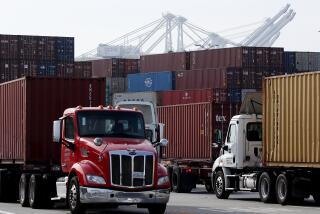Truckers See More Traffic Up Ahead
If the job doesn’t pay at least $1 a mile, Rodger and Heather Hogeland won’t take it.
The way their expenses add up, they have to gross that much to earn a decent profit, which by U.S. truck drivers’ standards is 32 to 34 cents a mile. They raised five kids making that kind of money, hauling produce from Salinas, Calif., to Syracuse, N.Y., on a weekly transcontinental loop that since 1999 has put 1.2 million miles on their purple Kenworth W900L tractor-trailer rig.
A U.S. Supreme Court decision, the Hogelands fear, could mean the end of the road for them.
The court last week overturned a ruling that had prevented Mexican trucks and buses from delivering goods and passengers in this country. Once the Department of Transportation sets up an inspection program to ensure that vehicles entering the U.S. meet federal safety standards, as many as 34,000 Mexican trucks could be in business north of the border -- trucks driven by men and women used to netting about 13 cents a mile.
“We have been praying that this wasn’t going to happen,” said Heather Hogeland, 47, a second-generation trucker whose father taught her how to drive big rigs when she was 20.
In Mexico, “the cost of living is so low that you can afford to earn pennies per mile and still feel like you are making money.”
At the Flying J truck stop outside Temple, Ga., a few days after the decision came down, she and her husband considered the dinner menu and the nightmare of tens of thousands of new competitors, all of them willing to drive for less than the Hogelands can afford.
What they found particularly galling was President Bush’s backing of the provision in the North American Free Trade Agreement that, with the high court having cleared the way, gives licensed Mexican truckers permission to transport international goods in the U.S.
“We were big Bush supporters,” Heather Hogeland said, “but on this, he has no clue.”
For 22 years, Mexican trucks have been allowed to operate only in narrow commercial border zones, where goods are transferred to U.S. trucks for delivery around the nation.
The lifting of that moratorium is widely supported by businesses on both sides of the border and especially north of it, where the hope is that shipping costs will be substantially reduced.
There are plenty of people who see the end of the ban in a different light, including environmentalists. Mexican long-haul trucks are generally older than those licensed in the U.S., with many built before the most recent round of anti-pollution standards for U.S. vehicles were set in 1993.
For members of the California Trucking Assn. and others in the business, it’s all about the fairness of competition. Stephanie R. Williams, senior vice president of the California group, said the effect on this border state would be the most severe, in part because of the proximity of the ports of Los Angeles and Long Beach to the Mexican border.
Mexican drivers could move international freight from the ports to anywhere in the U.S., she said, taking hauling jobs from Americans by undercutting on price.
For the Hogelands, the worry is more than about their livelihood. Their Kenworth, powered by a 600 horsepower Caterpillar 3406e engine, is their hobby too, a show rig they’ve entered in many contests. It’s painted a deep shade of purple, with stylized flames erupting from the engine cowl. In the cab, there is a full-size bed, a refrigerator, a microwave oven, a television set, a DVD player and a satellite radio. Rodger Hogeland described the cab as big enough “to fit a Ford Focus in there.”
At night, on flat roads, the rig is visible for miles. “We’ve got about 300 lights on it,” Heather said.
She said she and her husband, who met 20 years ago when they were instructors at a California truck-driving school, had found it increasingly difficult to eke out profit, particularly with the price of diesel fuel at a record high. With modified gearing and a turbo wing, their truck gets 5 miles per gallon, average for long-range rigs.
“It costs us about twice now what it used to for a drive from Salinas to Syracuse. Round trip, we used to spend about $1,500 for fuel. Now, it’s about that much one way. If we hadn’t paid off the truck, I don’t know what we would have done,” she said.
The time they spend on the road would test the imaginations of even freeway-bound California commuters. This week, like every week, they crossed the country. The leg out, from Salinas to Syracuse, is the bread-and-butter route, a long-term contract to haul fresh produce.
On that leg, they can gross upward of $1.25 a mile.
Most often, they tank up after they leave California, buying diesel where a gallon is 70 cents cheaper: Oklahoma City.
This week, after the drop-off in upstate New York, they headed south with paper products for Georgia.
In Montgomery, Ala., they picked up a load of frozen corn dogs to deliver to Turlock, Calif. In between were stops in Shreveport, La., for more fuel, then Dallas, where they bedded down for the night.
The marathon drives, round trips of as many as 6,300 miles, mean the Hogelands have very little time to spend in their mobile home in Fontana. A standing source of amusement is the mail they get from the dealership that sold them their 2003 Jeep Liberty, advising them that it’s time to come in for servicing.
“We haven’t been home enough to even break in the engine,” Heather said. “It just sits there.”
Both of their fathers were independent truckers. Rodger, 56, is a Vietnam veteran who gave up a career as a sheriff’s deputy in Jefferson County, Ala., for a life on the road with his wife. As for Heather, her story sounds like a country and western song. She gave up low-paying jobs, a cashier at a gas station, for example, and as a worker on a factory line that made plastic caps for aerosol cans, to drive trucks, starting out on short routes to Nevada and Arizona. She brought her son Kirk, now 26, along with her on the otherwise solo trips until he was old enough to begin school.
Last year, the Hogelands earned about $40,000, after taxes and expenses. When the Mexican competition shows up, they figure they’ll struggle to do that well.
“The only way we can make more money,” Heather said, “is to just work harder.”











